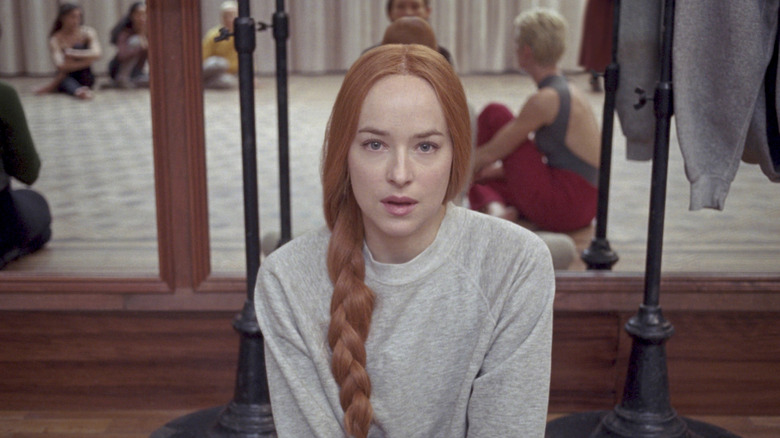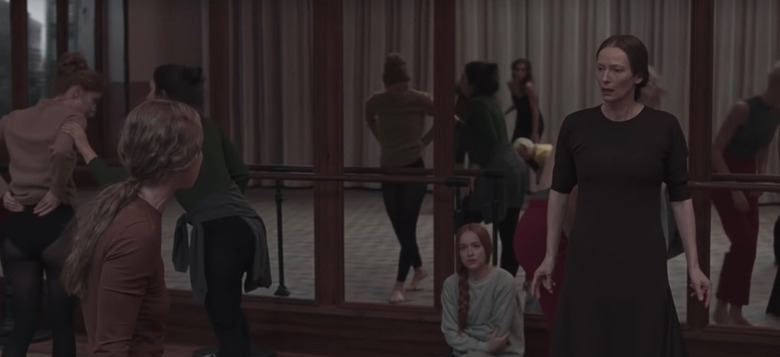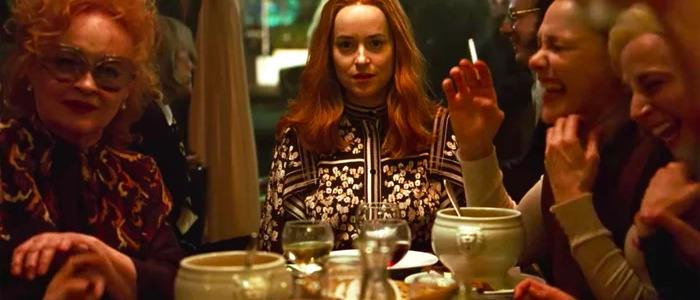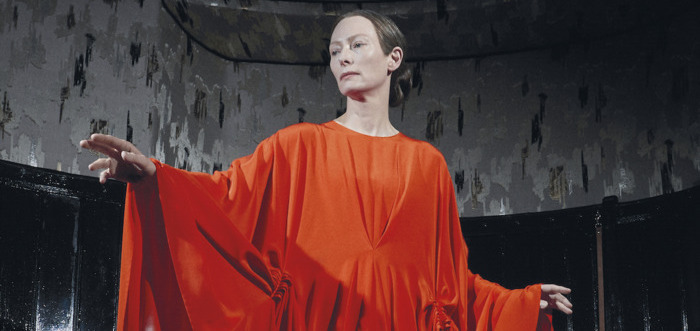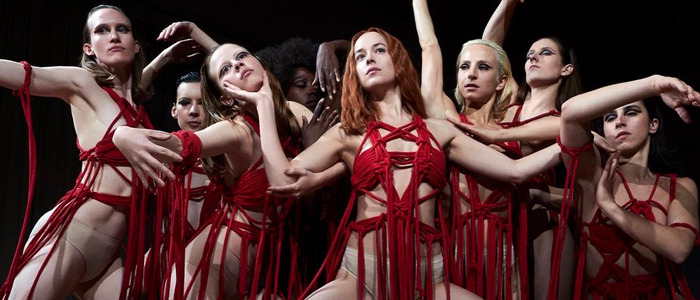'Suspiria' Spoiler Review: Exploring The Dark Nooks And Crannies Of The Best Horror Remake Ever Made
The halls of the Markos Dance Academy are barren; blanched of color and body, wide deco door frames and high ceilings gape like hungry mouths. The sizes seems preposterous for how few people dwell there: a handful of young women in the company and their teachers. But though the women are small in number, there exists in their building an unflinching, insurmountable terror. A thicket of wicked in its bowels. Numbers don't matter when evil is thirsting in the shadows.
Luca Guadagnino's palatial Suspiria — a remake of Dario Argento's 1977 original — is in a league of its own, arguably the most interesting horror remake of all time, and definitely the best. Assembled into six chapters and an epilogue, it's a nearly 3-hour behemoth, which will annoy some and liberate others, while forging a cinematic identity unto itself. You've never seen anything quite like this. You might be grateful for that.
1977
Suspiria opens in Berlin during the German Autumn of 1977, a time of post-WWII political unrest in Germany, when the Red Army Faction — a far-left militant organization — was rebelling terroristically against its own country. The Berlin Wall was still a functioning division, and serves as a major setting in the film. It was a time of unrest, of provocation, of a city passively acknowledging the destruction of whole swaths of its population.
Markos' inner dramatizations mimic the political discordance happening through those doors, where the Wall lingers monolithically. This is a movie about the exterior reflecting interior elements; a coven of antiquated witches tells us how to feel about about a country still in turmoil.
This is best evidenced in the film's opening moments, when Patricia Hingle (Chloë Grace Moretz) visits her psychiatrist, Dr. Josef Klemperer (Tilda Swinton in impressive but distracting stage makeup). She tells him that she's being undone by Markos, whose teachers are swept up in a witchy coven obsessed with using young blood to uphold a traditional hazing ritual, in service of the three "mothers": Mother Lachrymarum (Mother of Tears), Mother Tenabrarum (Mother of Darkness), and Mother Suspiriorum (Mother of Sighs).
Klemperer, like most men presented with truth, thinks Hingle fanatical. He ignores her, and then she disappears. His passive inaction repeats the sins of his countrymen. It sets the stage for Suspiria's driving point.
Borrowing/Taking
Susie Bannion (Dakota Johnson) arrives at Markos with a mission. As we learn through flashbacks to her Mennonite childhood in Ohio, she was always drawn to Berlin, always knew she had a part to play in this story; a chosen one, so to speak. She dances for the teachers — including a leering Madame Blanc (Tilda Swinton), the head of the company — in an undulating display of body and soul. She was, quite literally, born to dance. It's a release of her religious upbringing, her repression. She makes love to the floor as she stomps, twists, bends.
Susie immediately befriends a fellow Markos member, Sara Simms (Mia Goth), and the two gossip through the sound of bombs exploding outdoors. This is the world they live in; one of casual chaos and death. It lives in both the radicalism taking place outside, and in the dances they perform for Markos. Red rope, white paint, bodies moving intrusively.
The performance the company is working on is called Volk, a reimagining of a dance Blanc choreographed decades earlier, and nod to the film's remake roots. But the performance is interrupted as a rebellion strikes up within Markos, after one member, Olga (Elena Fokina), questions what's happened to Patricia. It is through her protestations that we learn the teachers really are a coven — like Patricia had warned Klemperer — and they punish Olga with unspoken, barbaric magic.
As Susie assumes the lead in the Volk choreography, Olga — in a mirrored room that will haunt your dreams — bends, snaps, and breaks like a deranged voodoo doll. She is tossed about the room, her bones cracking and her body evacuating fluids — saliva, urine, blood — in a horrific display. Once she's twisted into a human pretzel, the teachers arrive, surround her, and hack at her body with silver hooks; another one of their rituals. They then carry her body into the shadows.
All the floors are darkness
The Markos coven is a fascinating depiction of feminine magic. The women are older, worn in their ways. We're never entirely sure how they met or the true function of their sorcery, but we know it's ritualistic in nature, almost alchemic. The teachers are not cruel, but rather feel obligated to service the mothers, no matter the grave cost. But there is still an odd, backwards sort of love that radiates through the company. Blanc moves cooly through the world, but not unkindly. Swinton imbues her with warmth; her conversations with Susie feel maternal, an interesting contrast to the images of Susie's real mother back in Ohio, who is on her death bed. "She is my sin," Mrs. Bannion says of her daughter.
But Susie thrives at Markos. Her dancing improves as those around her fall, as if she's feeding on them. She steals from Olga the choreography, from fellow member Caroline (Gala Moody) the ability to jump, and from Sara an intimacy with the company. When it's time to dance Volk, she is at full capacity, her face striped with white paint, her body at the peak of its capabilities. But below Susie, in the building's lower levels, Sara — who has grown curious about Patricia's absence after speaking to Klemperer — finds the twisted, decayed bodies of her missing classmates; pruned by the sorcery of the coven. She then encounters the witches herself, breaking her leg as she attempts to escape. They heal her and put her under a trance, and she joins the Volk performance midway through, her eyes changed from brown to blue — and Susie's changed from blue to brown. Sara collapses at the end of the performance, to the worry of the audience, including Klemperer, who attends due to his own suspicions.
Suspiria is best when it is fully infatuated with Susie's ascent. The Volk performance is a master class in visual storytelling, as are the dreams the coven gives Susie to experience; chaotic, nightmarish flashes of women floating, skin burning, blood curdling. It's a perverse rendering of the "chosen one" trope. She is quite literally bewitched by this new life. Johnson uses her body like an instrument. Though her whispery vocals feel a little off, the sheer force of her physical performance betrays any concept of meekness.
A Sliced-Up Pear
The most bizarre choice Suspiria makes is in regards to Klemperer, a character who doesn't quite work the way the script seems to think he does. Klemperer bookends the film; we open on Patricia in his office, and we close on a scene that "forgives" him his crimes of passive interaction.
Guadagnino apparently cast Tilda Swinton as Klemperer to keep the film rooted firmly in the feminine. But that logic is confusing; Klemperer is undoubtedly male, no matter who's playing him, and it's hard to figure out how a woman playing the part really changes anything. The character exists to witness the Markos women through the eyes of a stranger, and to sit back as they are tortured and mutilated. He is also given the most backstory of any character; we learn that his wife, Anke (Jessica Harper, who played Suzy Bannion in the original film), went missing during World War II as she fled the Nazis. Klemperer sullenly visits their old home in East Germany, passing through the wall just to linger on the past he cannot retain. Under the spell of the witches, he is granted another visitation with Anke; but she's a mirage. As we learn in the film's epilogue, Anke died in a concentration camp.
Suspiria attempts to wrangle with its own hierarchy through Klemperer. This is a story about women being told entirely by men: Guadagnino and screenwriter David Kajganich. Even the intimate score is done by a man, Radiohead's Thom Yorke. Klemperer feels like an admission of this, a meta way of detailing the ways men occupy and harm female narratives.
But I'm not sure it works. Klemperer is a bit of an eye sore, both because of Swinton's distracting prosthetics, and because he sucks the air out of the more compelling plot elements. I can't be sure, but it feels like the movie includes more shots of him than of Susie, despite it being her story. Is it even her story if the movie never engages with her the way it does Klemperer? In the epilogue, when Susie comes to his bedside, after fully obtaining her powers, I expected her to kill him. Instead, she erases his memories; absolving him of guilt, while also robbing him of joy. It's a complicated moment, and a shame that so much time is spent on this inconsequential man as opposed to the far more interesting Markos women.
Suspiriorum
The Klemperer mess aside, the final act of Suspiria is a mesmerizing, beautiful experience, one that enacts female power and speaks to the chaos of 1977 Berlin at the same time. Just as Germany would learn to address the past and reforge a new identity, so does the Markos coven, with the aid of Susie, who is in fact Mother Suspiriorum.
During a sabbath-like processional in the building's bowels — where the coven plans to sacrifice Susie and use her body as a vessel for Mother Helena Markos (also played by Tilda Swinton, this time looking like a cenobite from Hellraiser) — the truth comes out. Susie is the fated mother and Markos is a phony, chewing through female bodies to mask her lies. When Susie's true identity is revealed, the sabbath turns extravagantly bloody; Mother Suspiriorum cleans house, slaying those who betrayed her, sparing the sorry, and mercifully killing Patricia, Olga, and Sara, who all plead to die.
Order has been restored to the company, but its matriarch — Madame Blanc — is gone; Markos snapped her back before Susie retaliated, and she lingers on in the basement room in her destroyed form. It's unclear if she's alive or dead.
Susie, meanwhile, has obtained her final form; her Mother Suspiriorum will unite the coven not through bloodshed or sacrifice, but love and repurposing. The film may close on Klemperer's absolution, but it's her journey that lingers, and begs the question of what's next. The creators have teased the film could get a sequel; it would be fascinating to see Mother Suspiriorum in a restored Germany, or a new location entirely, rectifying the world from the inside out, as she's done before.

